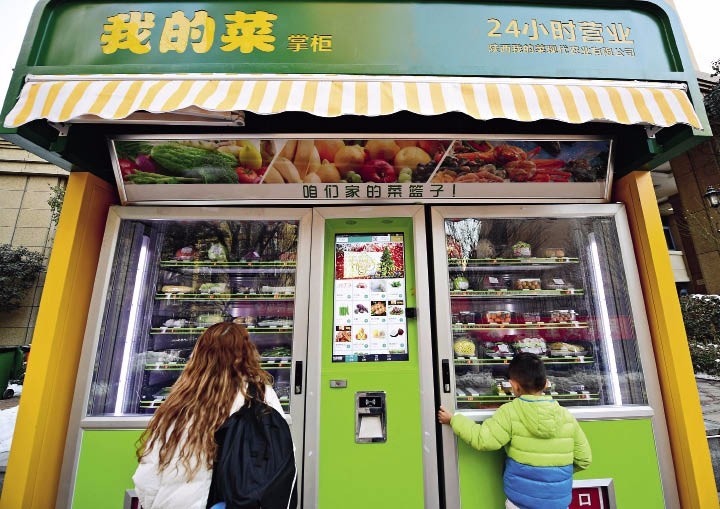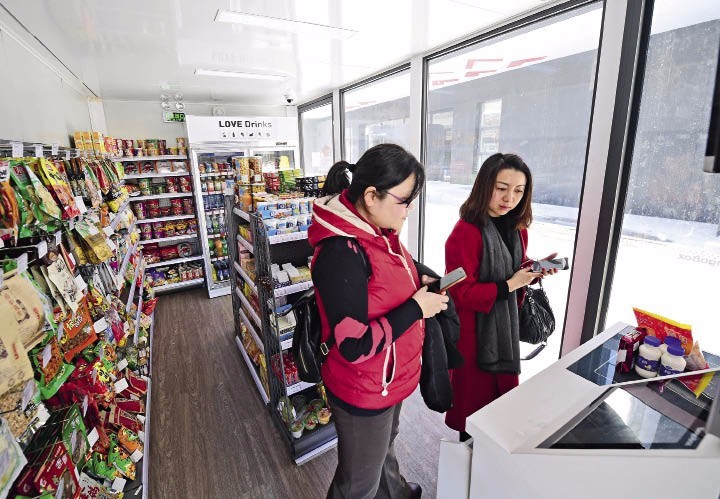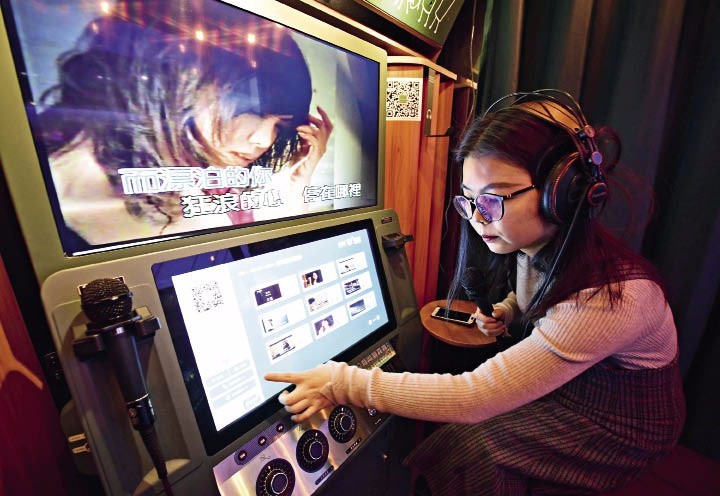On January 9, 2018, a resident is buying vegetables at a vending machine in a community in Xi’an, Shaanxi Province.

Unmanned Services
In December 2016, Amazon launched its first unmanned store, Amazon Go, in Seattle. Compared to this, China’s unmanned retail seems to have started even earlier. This is due to the simple and honest folkway cultivated by China’s agricultural society for thousands of years. In a vegetable market in Jiangkou Village, Yulin City, Guangxi Zhuang Autonomous Region, the stalls are left unattended and the customers choose vegetable by themselves and pay for it based on the honor system. This market has been in operation for hundreds of years.
Influenced by traditional moral restraint, after entering the modern society, unmanned retail has become popular.
An unmanned community supermarket in Tianjin has been in operation since December 2011, and all transactions are based on integrity. A report in 2015 showed that the supermarket not only lost zero goods, but also gradually increased its turnover.
An unmanned newsstand in Linli Township in Nanning City, Guangxi Zhuang Autonomous Region, has a daily sale of 100 copies of various newspapers on average. There are very few cases of theft.
With the popularization and application of network technologies, unmanned retail has brought new experiences to consumers. Every move is digitized and streamlined. Products and payments are also digitized. The shopping process is sped up, simplified, and consumers are enjoying the increased convenience brought about by technology. Today, all this is becoming a reality. China’s retail industry is undergoing a self-revolution and gradually realizing the integration of online, offline, payment and logistics. The era of isolated, pure e-commerce or pure brick and mortar may soon become obsolete.
In Shenzhen, Guangdong Province, an unmanned convenience store opened in March 2017. The owner rarely goes to the store except for a routine visit now and then to replenish its commodities. Today, this shop’s “trust” feature continues to attract visitors.
Unmanned retail is just one field of unmanned services, and there are a great many commercial opportunities for unmanned services in the fields of entertainment, life, and health. The popular mini-KTV, self-service library, and photo printers are unmanned services for both learning and entertainment. Bike sharing, self-service car washing, self-service gas stations, smart delivery lockers, unmanned restaurants, and unmanned hotels, shared power banks, shared umbrellas, are unmanned services for ease and quality of life. Self-service fitness rooms, shared massage armchairs are unmanned services for health. With the advancement of science and technology and the improvement of the overall moral level of the society, unmanned services will eventually be fully integrated in the life of ordinary people. On the premise of integrity, a good experience will boost unmanned services to new heights.
This new business model reliant on digital technology has brought consumers good experiences in various scenarios, and has met the growing needs of people for a better life. A survey of 2008 respondents jointly conducted by China Youth Daily and wenjuan.com showed that 76.2 percent of the respondents had a good experience of the unmanned economy and 60.4 percent of respondents believed that the unmanned economy provides a timely, convenient, and diverse consumer experience.
Meanwhile, the unmanned economy has also provided great benefits for businesses. It not only saves on labor costs and operating costs, but also broadens sales and service channels. In particular, closed-loop services are formed through mobile payments, and big data technologies can be used to analyze and forecast users’ consumption preferences, habits, and potential, which in turn can guide businesses to provide more personalized unmanned services.
In the long run, what’s behind the development of the unmanned economy is the escalation of consumer demand for rapid, convenient, quality, and diverse services, meaning that the entire service industry will also accelerate the change as consumers become more “diversified, technology-savvy, and fashion-conscious” to boost consumption upgrades.

On January 9, 2018, a resident is buying vegetables at a vending machine in a community in Xi’an, Shaanxi Province.
Unmanned Factories
Longlide Packaging and Printing Co., Ltd., an unmanned factory in Fengxian District of Shanghai, has nearly 15,000 square meters of factory buildings with two assembly lines. Only eight university graduates are in charge of operating the software. Other “employees” consist entirely of automated equipment such as single-arm robots, palletizing robots, and automatic guided vehicles. It is estimated that using traditional technology to achieve the output of this factory requires 1,000 workers.
Unmanned production does not mean the complete absence of people. It is reliant on information technology and robotics technology to achieve automatic, digitalized, and intelligent production. The number of workers on the adjusted production line has plummeted, from material distribution and assembly to packaging. The scene of crowded workers in the old factory buildings is now gone.
Surprisingly, this unmanned factory does not produce high-end manufacturing products such as automobiles. Instead, it produces cartons and boxes. Packaging printing and book printing are not emerging industries, but this company has gone down a new path to turn the fading industry into an innovative one.
At present, a growing number of manufacturing companies are beginning to experiment with unmanned factories, because in the manufacturing industry, especially in the area of assembly line production, the demand for human initiative and creativity is greatly reduced, and with a lower efficiency the laborer is more prone to errors. In addition to this, with social development, laborers are increasingly disinterested in work that is monotonous and labor-intensive; the situation is further worsened by labor shortages and higher costs. The emergence of unmanned factories reduces the reliance on manpower for production. Enterprises can also be relieved of labor shortage. Some workers can also be freed from dangerous and arduous work. From this point of view, the emergence of unmanned factories does more good than harm for companies and workers.
Compared with traditional factories, the effect of improving quality and reducing costs in unmanned factories is significant. Shenzhen Everwin Precision Technology Co., Ltd. is a pioneer in unmanned production. Taking into account the cost and risk issues, Everwin first tried to replace workers engaged in polishing operations in the production of precision metal components with robots. Before the use of robots, Everwin needed to spend RMB 10,000 each month on an experienced polishing worker. With the use of robots, the efficiency is 2.5 times that of the manned version, and the product qualification rate is higher. Calculating according to the company’s output value, it takes only one year to recover costs. In other words, after one year’s production, the original labor cost is converted into corporate profits, which will undoubtedly allow companies to attain more competitiveness in similar products.
It should be noted that Everwin is only using robots in a certain production process. This is not a real unmanned factory, but its cost reduction is already very evident. It can be imagined that the cost savings would be quite impressive if the entire factory was unmanned.

On January 10, 2018, a girl selects songs in a mini KTV at a shopping mall in Xi'an.
The Pain of an Unmanned Economy
Unmanned economy has certain problems in bringing convenience and benefits to consumers. As everyone knows, the cornerstone of the unmanned economy is technology. If technological standards are not met, or cheating is done on workmanship and materials, then the benefits will not be visible. For example, sometimes a consumer uses a vending machine, the machine does not ship after the payment, the change cannot be refunded, or the verification code cannot be entered.
At the same time, the unmanned economy mostly provides simplified services. For instance, mini-KTV can only replace the traditional KTV’s singing function because of limited space, and the effects of interaction and active scenes are greatly reduced. For an unmanned noodle shop, customers have mixed feelings: although the taste of machine-made noodles is relatively simple, it is fast and cheap. In order to attract customers, there is still room for improvement in the catering field.
For some specific industries, the implementation of unmanned operations will also bring security risks. For example, dangerous and explosive items such as gasoline and diesel make it challenging and difficult to ensure safety in unmanned gas stations. Unmanned payment links may also bring insecurity to personal funds. According to industry insiders, customers’ acceptance of a password-free payment is about 15 percent, and they need more time to fully accept this mode of payment.
As a new business model, its development rate is faster, while laws, regulations, and government supervision do have a bit of lag. Many problems involved are in the periphery of the law. The older laws and regulations are difficult to adapt to the development needs of the unmanned economy.
According to a survey conducted by China Youth Daily, 65.4 percent of respondents are worried about information security and privacy protection in the unmanned model, and 64 percent are concerned that consumers’ legal rights are not effectively protected. 61.3 percent are concerned that problems in the consumption process could not be resolved in a timely manner. 51.2 percent are concerned that the companies have excessively collected personal information, and 36.4 percent are worried that they could not get relevant product consultation.
Wu Yuqi, executive vice president of the China Industrial Internet (Zhejiang) Institute, believes that the unmanned economy heralds the arrival of a new lifestyle and production methods. It also shows that science and technology are constantly developing. However, at present, its security and operability remain to be tested.
The unmanned economy may not involve people or cash, but there must be rules and regulations. Therefore, experts believe it is necessary for relevant departments to formulate or improve relevant laws and regulations, clarify the nature of the unmanned economy mode, standards, access conditions, obligations of operators, consumers’ rights, scope of boundaries, and supervisory departments of the unmanned economy to fill in legal gaps. At the same time, relevant companies and industrial organizations should also formulate and improve related rules, strengthen awareness, achieve self-discipline, self-regulation, and self-development.
There is no fundamental contradiction between the unmanned economy and the traditional economy, because their most basic aims are to serve people, but the unmanned economy can further reduce operating costs and bring benefits to consumers. This is an irreversible tide of development.